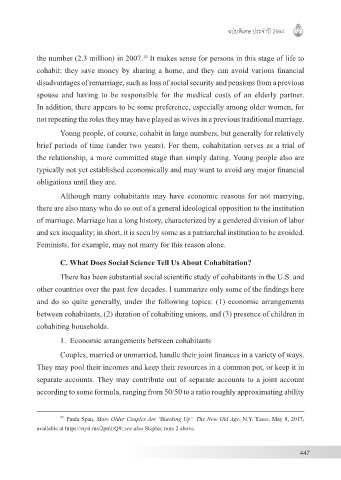Page 449 - วารสารกฎหมาย ศาลอุทธรณ์คดีชํานัญพิเศษ
P. 449
ฉบับพิเศษ ประจำ�ปี 2564
the number (2.3 million) in 2007. It makes sense for persons in this stage of life to
10
cohabit: they save money by sharing a home, and they can avoid various financial
disadvantages of remarriage, such as loss of social security and pensions from a previous
spouse and having to be responsible for the medical costs of an elderly partner.
In addition, there appears to be some preference, especially among older women, for
not repeating the roles they may have played as wives in a previous traditional marriage.
Young people, of course, cohabit in large numbers, but generally for relatively
brief periods of time (under two years). For them, cohabitation serves as a trial of
the relationship, a more committed stage than simply dating. Young people also are
typically not yet established economically and may want to avoid any major financial
obligations until they are.
Although many cohabitants may have economic reasons for not marrying,
there are also many who do so out of a general ideological opposition to the institution
of marriage. Marriage has a long history, characterized by a gendered division of labor
and sex inequality; in short, it is seen by some as a patriarchal institution to be avoided.
Feminists, for example, may not marry for this reason alone.
C. What Does Social Science Tell Us About Cohabitation?
There has been substantial social scientific study of cohabitants in the U.S. and
other countries over the past few decades. I summarize only some of the findings here
and do so quite generally, under the following topics: (1) economic arrangements
between cohabitants, (2) duration of cohabiting unions, and (3) presence of children in
cohabiting households.
1. Economic arrangements between cohabitants
Couples, married or unmarried, handle their joint finances in a variety of ways.
They may pool their incomes and keep their resources in a common pot, or keep it in
separate accounts. They may contribute out of separate accounts to a joint account
according to some formula, ranging from 50/50 to a ratio roughly approximating ability
10 Paula Span, More Older Couples Are ‘Shacking Up’: The New Old Age, N.y. tImes, May 8, 2017,
available at https://nyti.ms/2pmirQ9; see also Stepler, note 2 above.
447

